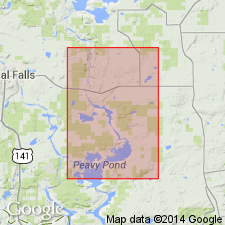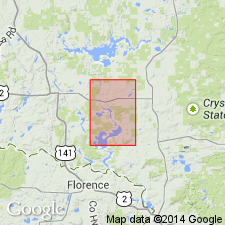
- Usage in publication:
-
- Peavy complex
- Modifications:
-
- Original reference
- Dominant lithology:
-
- Gabbro
- AAPG geologic province:
-
- Lake Superior region
Summary:
Peavy complex. Composed of gabbro with minor ultrabasic parts and fringed with intermediate and acid differentiates and hybrids. Intruded Hemlock and Michigamme formations during late middle Precambrian orogeny and metamorphism.
Source: US geologic names lexicon (USGS Bull. 1200, p. 2960).

- Usage in publication:
-
- Peavy Pond complex*
- Modifications:
-
- Original reference
- Dominant lithology:
-
- Metagabbro
- Metadiorite
- Metatonalite
- Granodiorite
- Granite
- AAPG geologic province:
-
- Lake Superior region
Summary:
Pg. 10, 75-80, 82-92, pl. 1. Peavy Pond complex as designated here includes all intrusive rocks exposed on shores and islands of Peavy Pond. Chiefly hornblende metagabbro and hornblende metadiorite. Cuts Hemlock and Michigamme formations in south part of Lake Mary quadrangle. Age is Precambrian. Report includes geologic map, stratigraphic chart, petrologic data.
[Type locality not stated.] Exposed on shores and islands of Peavy Pond, in secs. 14-17, 19-22, and 27-30, T. 42 N., R. 31 W., Iron Co., northwestern MI.
Source: US geologic names lexicon (USGS Bull. 1200, p. 2960); supplemental information from GNU records (USGS DDS-6; Denver GNULEX, Reston GNULEX).
For more information, please contact Nancy Stamm, Geologic Names Committee Secretary.
Asterisk (*) indicates published by U.S. Geological Survey authors.
"No current usage" (†) implies that a name has been abandoned or has fallen into disuse. Former usage and, if known, replacement name given in parentheses ( ).
Slash (/) indicates name conflicts with nomenclatural guidelines (CSN, 1933; ACSN, 1961, 1970; NACSN, 1983, 2005, 2021). May be explained within brackets ([ ]).

